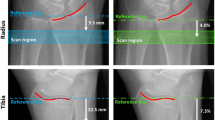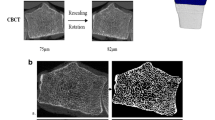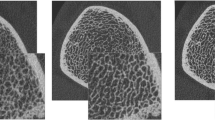Abstract
Obtaining high-resolution scans of bones and joints for clinical applications is challenging. HR-pQCT is considered the best technology to acquire high-resolution images of the peripheral skeleton in vivo, but a breakthrough for widespread clinical applications is still lacking. Recently, we showed on trapezia that CBCT is a promising alternative providing a larger FOV at a shorter scanning time. The goals of this study were to evaluate the accuracy of CBCT in quantifying trabecular bone microstructural and predicted mechanical parameters of the distal radius, the most often investigated skeletal site with HR-pQCT, and to compare it with HR-pQCT. Nineteen radii were scanned with four scanners: (1) HR-pQCT (XtremeCT, Scanco Medical AG, @ (voxel size) 82 μm), (2) HR-pQCT (XtremeCT-II, Scanco, @60.7 μm), (3) CBCT (NewTom 5G, Cefla, @75 μm) reconstructed and segmented using in-house developed software and (4) microCT (VivaCT40, Scanco, @19 μm—gold standard). The following parameters were evaluated: predicted stiffness, strength, bone volume fraction (BV/TV) and trabecular thickness (Tb.Th), separation (Tb.Sp) and number (Tb.N). The overall accuracy of CBCT with in-house optimized algorithms in quantifying bone microstructural parameters was comparable (R2 = 0.79) to XtremeCT (R2 = 0.76) and slightly worse than XtremeCT-II (R2 = 0.86) which were both processed with the standard manufacturer’s technique. CBCT had higher accuracy for BV/TV and Tb.Th but lower for Tb.Sp and Tb.N compared to XtremeCT. Regarding the mechanical parameters, all scanners had high accuracy (R2 \(\ge\) 0.96). While HR-pQCT is optimized for research, the fast scanning time and good accuracy renders CBCT a promising technique for high-resolution clinical scanning.





Similar content being viewed by others
References
Peacock M, Turner CH, Econs MJ, Foroud T (2002) Genetics of osteoporosis. Endocr Rev 23:303–326. https://doi.org/10.1007/s10354-005-0249-2
Hernlund E, Svedbom A, Ivergård M et al (2013) Osteoporosis in the European Union: medical management, epidemiology and economic burden: a report prepared in collaboration with the International Osteoporosis Foundation (IOF) and the European Federation of Pharmaceutical Industry Associations (EFPIA). Arch Osteoporos. https://doi.org/10.1007/s11657-013-0136-1
Blake GM, Fogelman I (2007) The role of DXA bone density scans in the diagnosis and treatment of osteoporosis. Postgrad Med J 83:509–517. https://doi.org/10.1136/pgmj.2007.057505
Kanis JA, Johnell O, Oden A et al (2008) FRAXTM and the assessment of fracture probability in men and women from the UK. Osteoporos Int 19:385–397. https://doi.org/10.1007/s00198-007-0543-5
Sanders KM, Nicholson GC, Watts JJ et al (2006) Half the burden of fragility fractures in the community occur in women without osteoporosis. When is fracture prevention cost-effective? Bone 38:694–700. https://doi.org/10.1016/j.bone.2005.06.004
Schuit SCE, Van Der Klift M, Weel AEAM et al (2004) Fracture incidence and association with bone mineral density in elderly men and women: the Rotterdam Study. Bone 34:195–202. https://doi.org/10.1016/j.bone.2003.10.001
Müller R, Hildebrand T, Rüegsegger P (1994) Non-invasive bone biopsy: a new method to analyse and display the three-dimensional structure of trabecular bone. Phys Med Biol 39:145–164. https://doi.org/10.1088/0031-9155/39/1/009
De Cock J, Mermuys K, Goubau J et al (2012) Cone-beam computed tomography: a new low dose, high resolution imaging technique of the wrist, presentation of three cases with technique. Skeletal Radiol 41:93–96. https://doi.org/10.1007/s00256-011-1198-z
Mys K, Stockmans F, Vereecke E, van Lenthe GH (2018) Quantification of bone microstructure in the wrist using cone-beam computed tomography. Bone 114:206–214. https://doi.org/10.1016/j.bone.2018.06.006
Mys K, Varga P, Gueorguiev B et al (2018) A comparative analysis between cone-beam computed tomography and high-resolution peripheral computed tomography for the quantification of bone microstructure in the wrist. J Bone Miner Res 34(5):867–874
Elizabeth JS, Biver E, Burt L et al (2019) Cortical and trabecular bone microarchitecture predicts incident fracture independently of DXA bone minderal density and FRAX in older women and men: the Bone Microarchitecture International Consortium (BoMIC). Lancet 7:34–43. https://doi.org/10.1016/S2213-8587(18)30308-5.Cortical
Mys K, Varga P, Gueorguiev B et al (2019) Correlation between cone-beam computed tomography and high-resolution peripheral computed tomography for assessment of wrist bone microstructure. J Bone Miner Res 34:867–874. https://doi.org/10.1002/jbmr.3673
MacNeil JA, Boyd SK (2007) Accuracy of high-resolution peripheral quantitative computed tomography for measurement of bone quality. Med Eng Phys 29:1096–1105. https://doi.org/10.1016/j.medengphy.2006.11.002
Buie HR, Campbell GM, Klinck RJ et al (2007) Automatic segmentation of cortical and trabecular compartments based on a dual threshold technique for in vivo micro-CT bone analysis. Bone 41:505–515. https://doi.org/10.1016/j.bone.2007.07.007
Flaig C (2012) A highly scalable memory efficient multigrid solver for micro-finite element analyses. ETH Zurich
Pistoia W, van Rietbergen B, Lochmüller E-M et al (2002) Estimation of distal radius failure load with micro-finite element analysis models based on three-dimensional peripheral quantitative computed tomography images. Bone 30:842–848
Kothari M, Keaveny TM, Lin JC et al (1998) Impact of spatial resolution on the prediction of trabecular architecture parameters. Bone 22:437–443. https://doi.org/10.1016/S8756-3282(98)00031-3
de Charry C, Boutroy S, Ellouz R et al (2016) Clinical cone beam computed tomography compared to high-resolution peripheral computed tomography in the assessment of distal radius bone. Osteoporos Int 27:3073–3082. https://doi.org/10.1007/s00198-016-3609-4
Klintström E, Klintström B, Moreno R et al (2016) Predicting trabecular bone stiffness from clinical cone-beam CT and HR-pQCT data; an in vitro study using finite element analysis. PLoS ONE 11:1–19. https://doi.org/10.1371/journal.pone.0161101
Klintström E, Klintström B, Pahr D et al (2018) Direct estimation of trabecular bone stiffness using cone-beam computed tomography. Oral Surg Oral Med Oral Pathol Oral Radiol 126:72–82. https://doi.org/10.1016/j.oooo.2018.03.014
Verhulp E, Van RB, Müller R, Huiskes R (2008) Indirect determination of trabecular bone effective tissue failure properties using micro-finite element simulations. J Biomech 41:1479–1485. https://doi.org/10.1016/j.jbiomech.2008.02.032
Macneil JA, Boyd SK (2008) Bone strength at the distal radius can be estimated from high-resolution peripheral quantitative computed tomography and the finite element method. Bone 42:1203–1213. https://doi.org/10.1016/j.bone.2008.01.017
Graeff C, Marin F, Petto H et al (2013) High resolution quantitative computed tomography-based assessment of trabecular microstructure and strength estimates by finite-element analysis of the spine, but not DXA, reflects vertebral fracture status in men with glucocorticoid-induced osteoporosis. Bone 52:568–577. https://doi.org/10.1016/j.bone.2012.10.036
Acknowledgements
The authors are not compensated and there are no other institutional subsidies, corporate affiliations, or funding sources supporting this study unless clearly documented and disclosed. This research was supported by a FWO travel grant (Grant No. V438418N), KU Leuven Internal Funding (Grant No. C24/16/027) and the Swiss National Supercomputing Centre under Project ID 891. The authors would like to thank Ursula Eberli (AO Research Institute Davos, Davos, Switzerland) for assistance with the IPL software and Dieter Wahl (AO Research Institute Davos, Davos, Switzerland) for assistance with the development of scanning techniques and the development of scanner-specific holders.
Author information
Authors and Affiliations
Contributions
Study design: KM, PV, FS, BG and HVL. Data collection: KM, VN, OV, CW and JVB. Data analysis: KM and PV. Data interpretation: KM, PV, FS, BG and HVL. Drafting manuscript: KM. Revising manuscript content: PV, FS, BG, VN, OV, CW, JVB and HVL. Approving final version of manuscript: KM, PV, FS, BG, VN, OV, CW, JPV and HVL. KM takes responsibility for the integrity of the data analysis.
Corresponding author
Ethics declarations
Conflict of interest
Karen Mys, Peter Varga, Filip Stockmans, Boyko Gueorguiev, Verena Neumann, Olivier Vanovermeire, Caroline E. Wyers, Joop P.W. van den Bergh and G. Harry van Lenthe declare that they have no conflict of interest.
Human and Animal Rights and Informed Consent
Nineteen human cadaveric radii (11 right, 8 left) of 14 female and 5 male donors aged between 25 to 93 years (mean ± standard deviation (SD): 67.9 ± 16.2 years) were used. The specimens were obtained from Science Care (Phoenix, AZ, USA) following study approval by the institutional internal review board, based on the approval of the specimens’ delivery by Science Care Ethics Committee. All donors gave their informed consent inherent within the donation of the anatomical gift statement during their lifetime.
Additional information
Publisher's Note
Springer Nature remains neutral with regard to jurisdictional claims in published maps and institutional affiliations.
Rights and permissions
About this article
Cite this article
Mys, K., Varga, P., Stockmans, F. et al. High-Resolution Cone-Beam Computed Tomography is a Fast and Promising Technique to Quantify Bone Microstructure and Mechanics of the Distal Radius. Calcif Tissue Int 108, 314–323 (2021). https://doi.org/10.1007/s00223-020-00773-5
Received:
Accepted:
Published:
Issue Date:
DOI: https://doi.org/10.1007/s00223-020-00773-5




